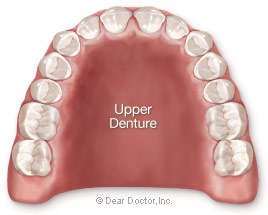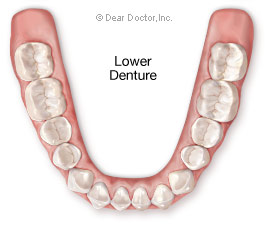Removable Full Dentures
A time-tested, affordable way to replace missing teeth
(Continued)
Foundations
Making removable full dentures essentially involves rehabilitating the stomatognathic system (“stomato” – mouth; “gnathic” – jaws) — the jaw joints, ligaments, nerves, and muscles — to work in new ways. This reorientation involves learning to help stabilize the dentures and manipulate them subconsciously to allow speech, biting and chewing, smiling and laughing, and enjoyment of a proper diet and nutrition. With a little practice, denture-wearers can look and feel completely normal — enhancing both social and psychological well-being.
The foundations upon which dentures rest are the arch-shaped residual alveolar ridges, the structures that used to support the teeth. In addition, upper dentures are supported by the immovable part of the roof of the mouth or hard palate, and extend around the sides of the ridges into the turn of the cheeks, an area known as the vestibule. This creates a rather large surface area onto which a well-fitting full upper denture can seal via a suctioning effect, enhancing stability.
 |
| Note the size difference in surface area between an upper and lower denture. In the upper denture, the palate provides a stable, rigid surface that creates good suction particularly when the gum ridges are substantial. The lower denture has much less surface area and can be more easily destabilized by the tongue, making it more difficult to wear. This can cause anxiety when speaking, eating and chewing. |
 |
The lower residual alveolar ridge has significantly less surface area upon which to seat and stabilize a denture. The more vertical and hill-shaped the residual lower ridge, the more surface area a lower denture can be made to rest upon, and the more stable it will be. Conversely the flatter the ridge, the more unstable the lower denture. Studies have shown that lower dentures in particular are more stable and in turn stabilize the jawbone when supported by and attached to at least two implants.
The dentures must also function and balance in the same space as previously occupied by the teeth, between the muscle forces of the lips, cheeks and tongue. By replacing teeth, full dentures also support the facial skeleton and soft tissues of the lips and cheeks, rejuvenating appearance and functionality. Wrongly shaped and sized, dentures can slip and move around.
Horseshoes — By taking detailed impressions (molds) of the residual ridges, denture bases can be made; the bases, made of a light cured plastic resin, become the fitting surfaces of the dentures. Horseshoe-shaped rims made of wax are then attached to them, which simulate the position of the teeth and gums. It has been said that “horseshoes is a game that's simple to play, but tough to master,” and the same applies here. The rims require experience to position correctly, for ultimately they will form the basis of the new position of the teeth and restore the dimensions of the face. Too much vertical opening can cause muscle pain and spasm, and excessive pressure on the remaining jawbone. If the rims are too wide they will also encroach upon the space for the lips, cheeks and tongue. If too narrow or short they will not be supportive enough and poorly tolerated.


